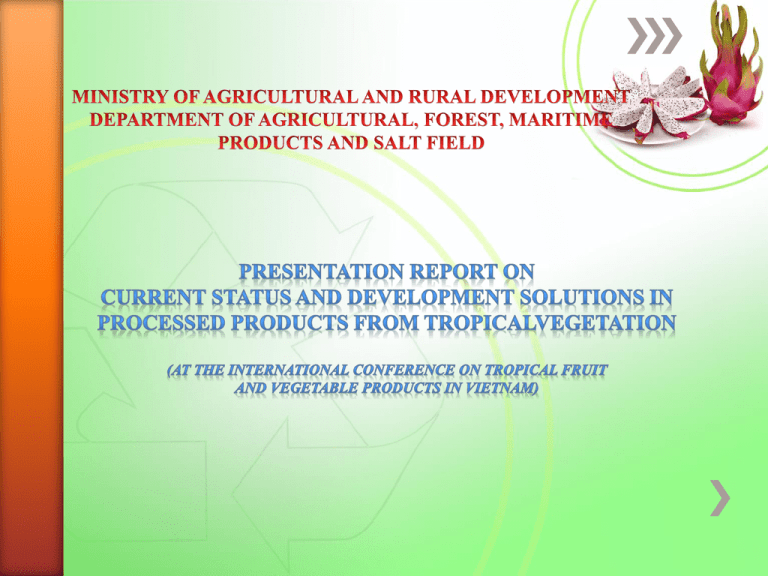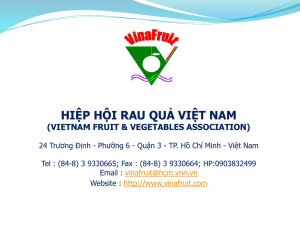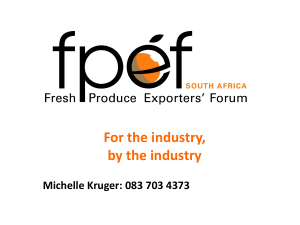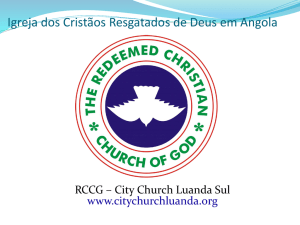Fruit and vegetable export turnover in the period of
advertisement

GENERAL With climate conditions, diverse natural , Vietnamese vegetation is quite rich in variety and a relatively large goods production zone has been formed such as lychee (Hai Duong, Bac Giang), longan (Hung Yen ), citrus (Ha Giang, Tuyen Quang, Hung Yen), pineapple (Ninh Binh, Tien Giang, Hau Giang), dragon fruits (Binh Thuan, Tien Giang), grapes (Ninh Thuan), mango (Tien Giang, Dong Thap ), rambutan (Dong Nai, Vinh Long), grapefruit (Ben Tre, Tien Giang, Vinh Long),etc. However, due to the characteristics of small production, the harvest and shortage in haverst and storage time , an inadequacy in collection, preservation, processing, consumption of fruits and vegetablesin Vietnam, the development is not propotional to its potential.Overall, fruit and vegetable products have not really brought the high goods characteristics, low added value. This is reflected in the stages from harvesting to processing, fruit and vegetable consumpting in the value chain of the following products: Collection, preservation, packaging, transportation - The collection is mostly made by hand, harvesting time has not been focused, mixing with two fruit types (unripen, ripen) and most of them are not sorted, cleaned; a large amount of fruits is bruised, and easily spoiled during the storage - Package for packing is not only insufficent but also inappropriate, mainly is used from sacks, bamboo baskets, even vegetables piled on the means of transport. Consequently the post-harvest losses of fruits and vegetables including quantity and quality are at a extremly high rate (25%). - Some facilities on growing and exporting somes of fruits such as dragon fruit, rambutan have practiced the appropriate classification, packaging, applied irradiation technology or pasteurization of hot water (depending on market requirements) initially bring high economic efficiency. However, the number of facilities like that is very limited. Collection, preservation, packaging, transportation The use of advanced storage technologies (storage in cool, stored by modified atmosphere, controlled atmosphere, etc) has just been in level of model. In some wholesale- markets of fruit and vegetable in major cities such as Ho Chi Minh, Hanoi cool stores have been invested , but only with the imported fruits with high value. 2. Processing - The percentage of processed vegetables is only at 10% of total production. The types of processed vegetables are canned foods such as vegetables mixed vinegar, sweet fruits, natural fruit juices, concentrated juice, puree, fried dry, frozen fruits Collection, preservation, packaging, transportation - The entire country has about 60 fruit and vegetable processing facilities by industrial scale with a total capacity of over 300,000 Total products/ year. The investment factories in the period from 1999 to the present have all reached the advanced level of technology and equipment provided from the developed industry countries of a new generation. Products such as concentrated pineapple, canned, frozen IQF, vacuum drying fried foods, etc are of high quality and meet customers requirements. However, the average factories only reach at 30% of design capacity (only some factories with the ready ingredients such as Dong Giao export foodstuff JSC, Bac Giang export foodstuff JSC, etc promoted of 50-70% capacity). Many factories have stopped producing due to lack of materials. Processed products are not diversified, less competitive in price stated in their packages, materials, transport freight, administrative procedures, qualification of production management and ability to offer products in large quantities. Collection, preservation, packaging, transportation Besides, there are also tens of thousands of processing facilities with small scale such as dried litchee in Luc Ngan (Bac Giang) with over 1,500 households; dried longan in Hung Yen: over 100 households; preversed cucumber in salt in Nam Dinh : 200 households, Vinh Phuc: 250 households, Thai Binh: 270 households. These facilities exist many risks of product safety and hygiene which should be controlled 3. Consumption Vietnamese vegetation is mainly for domestic consumption in fresh form. In general, as people's living standards is increasing more and more highly, their demand for vegetation is also growing consequently. However, it still faces many challenges: Fruit and vegetable export turnover in the period of 2000-2010 Unit: million U.S dollars Year 2000 Year 2005 Year 2006 Year 2007 Year 2008 Year 2009 Year 2010 213,6 235,5 260 305,6 406 439 451 - Because the economic and technical infrastructures have not developed yet(including roads, product distribution system), the transportation and consumption face many difficulties, especially with a condition that Vietnam is a nation located along latitude and vegetion products contains the characteristics of regions distinctively. - The control of quality, especially food hygience and safety, requires a change in the organization of production and perception of the producers. For Export: Export turnover of vegetables increases continously, but not be propotional. The vegetation export market has been expanding, the Vietnamese fruit and vegetable products have their apperance in over 50 countries and territories, the main export markets are China, Russia, Hong Kong, Taiwan, South Korea National, etc. A number of Fruit and vegetable export turnover in the period of 2000-2010 Marketssuch as Europe, America, Japan, Middle East, are in large demand but The Vietnam-exported fruit and vegetables are in limitation , because their quality hasnot overcomed technical barriers yet. -Types of fresh vegetables are exported mainly: + Fresh vegetables: cabbage, cauliflower, cucumbers, potatoes, taro, onion, garlic, vegetable beans ,etc + Fresh fruits: dragon fruit, watermelon, litchi, longan, mango, mangosteen, rambutan, banana, grapefruit, etc - Processed fruits and vegetables: + Canned vegetables: tomatoes, cucumbers, baby corn, bamboo shoots, etc. + Dried Fruits: litchi, longan, jackfruit, banana + Syrup Fruit: pineapple, litchi, longan, mango + Concentrated Juice: pineapple, passion- fruit, + Frozen Products: pineapple, litchi, rambutan, sweet corn, carrots, onions, etc. Fruit and vegetable export turnover in the period of 2000-2010 - Quality of export Vietnamese fruits and vegetables lacks the stability, some batches of goods have been complained by as the importers as issues of abundanceof presticide in fresh dragon fruit exported to Denmark in 2006, to British in 2007, peas in 2003 (abundances of Chlorothalonil, Carbendazim and Dithiocarbamates) and dragon fruit in 2008 (abundance of prochloraz) to Taiwan, nitrate content for processed pineapple products, content of heavy metal for canned litchi, Lactic Acid content of condensed pineapple, Puree litchi, (2008), etc or strange objects in the frozen vegetable exported to Japan (buttons, hair,etc) in 2007. Japan, Korea, Taiwan, USA, etc did not allow Vietnam importing the fresh fruits and vegetables from Vietnam due to problems of " fly pierces fruits ".Many years ago, Japan used to import the large numbers of frozen fruit Cherry (growing mainly in Go Cong - Tien Giang), but now it stops the import because "fruits are pierced by fly". II. Development Orientation 1- Forecasts of market trend Every year, nearly 600 million tons of vegetabkes and 500 million tons of fruits are required in the world . The Vietnamese Fruit and vegetable export market at that time and in the future is advantageous of both official export quota (large size) and unofficial export (small size). Up to now, the Vietnamese vegetables and fruis have been in over 50 countries around the world with the traditional Asian markets such as China, Taiwan, Hong Kong, Korea, Japan, etc; the Eastern Europe markets have been recovered. The strict markets with high quality requirements such as the U.S, the EU are gradually satisfied by Vietnamese manufacturers and manycontracts for importing Vietnamese fruits and vegetables are obtained . II. Development Orientation 2. SWOT analysis for vegestation processing industry of Vietnam - The Vietnamese vegetation industry in recent years has obtained certain achievements, annual export turnover has increased, however, the development of fruit and vegetable processing industry is not sustainable, particularly in the context of the regional and international economic integration. For development orientations and solutions, we consider the SWOT analysis (strengths, weaknesses, opportunities and challenges) of experts for Vietnames fruit and vegetable industry. II. Development Orientation Strengths: - Vietnam with favorable conditions of soil and climate (the tropical climate in the southand the subtropical one in the north) with a variety of specific vegetatation, has much more advantages compared to other countries in the region and the world; - Many processed vegetation products are produced under the line of modern technology, gradually increasingquality and types, models of products; - Growing speed of this sector is very fast, especially in the key areas: the Red River Delta, South-eastern region, Mekong River Delta, etc. II. Development Orientation Weaknesses: - Planting, harvesting, storage and processing technologies of fruits and vegetables are out-of-date . Consequences are of low fruits and vegetables quality, non-beautiful models, non-uniform specifications, abundant quantity, but low proportion of goods; - Large losses in post-harvest and preservationlead to high price of processing fruits and vegetables; - Organization of links in the vegetation production and trade does not neither ensure to make a collected strength nor ensure the production relationship between the sectors and the stages of fruit and vegetable processing development; - Food hygiene and safety standards for fruit and vegetable products including the fresh products and processed products is more and more high, strict and complex, especially in overseas markets. - Lack of the development strategy of key export goods, and spreading categories of goods . No comprehensive investment is made for the development of production and export of processed fruits and vegetables. Trade promotion, branding development, product improvement are proceeded slowly. II. Development Orientation 3. Solutions for development of fruit and vegetable processing industry Continue to implement development programs of vegetables and fruits and ornamental flowers under Decision No. 52/2007/QD-BNN dated 05/6/2007 of the Minister of Agriculture and Rural Development approved for development planning of vegetables and fruits and ornamental flowers to 2010, vision 2020 with the goal is to reach an vegetables, flowers, fruits export turnover of1.2 billion USD, then the following measures shall be taken: II. Development Orientation 3.1. Investment in developing vetegation materials zone Raw materials for processing factories shall meet the stable requirements of quality and quantity, crop spreading, and safety. To achieve the target of processed fruit and vegetable value and products in agriculture, it is necessary to carry out the following contrents: - Research to select vegetation seedswith high yield and good quality. Construction of the centralized fruit and vegetable areas, supplying raw materials to the processing factories at over 80% capacity. For fruit trees develop areas primarily in the South-eastern provinces , Mekong River Delta and Red River Delta; and for vegetables mostly in the Red River delta, the Mekong River Delta, South-Eastern region and Lam Dong. - Triển khai rộng rãi quy trình sản xuất rau quả theo hướng thực hành nông nghiệp tốt (GAP) nhằm đảm bảo tiêu chuẩn chất lượng và vệ sinh an toàn thực phẩm; - Develope widely process of vegetable production in the direction of good agricultural practices (GAP) to ensure quality standards and food safety and hygene; II. Development Orientation 3.2. Processing and preservation - Maintain of industrial processing capacity at 300 thousand tons/year as at present, concentrate on building the material areas to actively provide the processing factories; limit investment to more large factories, only focusing on intensive investment and product diversification ; strive in 2020 to reach the goal of 70-80% of design capacity for the line processing industry - Encourage the construction investment of fruit and vegetable processing facilities with small and medium scale in rural areas in accordance with the materials area and equipments mainly fabricated by engineering in the country but apply advanced technology, ensure technical standard and food safety and hygene; - Invest in the lines of classification, processing, packaging and storage in the fruit and vegetable wholesale markets to cater for the goods circulation between regions and for export. II. Development Orientation 3.3. Science and technology: - Strengthen research and transfer of science - technology in socialization trend to improve the quality and production efficiency of the processing industry. - Concentrate on investment and research to fabricate equipments for processing lines with small and medium scale, meet the requirements of modern technology, advanced and suitable equipments, low investment rate. - Apply advanced and modern preservation technology as per cool preservation, preservation in modified atmosphere environment, radiation,etc to create a breakthrough in preservation to reduce post-harvest losses, preservation period extension, long distance transportation (in the nation and for export, as well) and ensure food hygience and safety for consumers; - Develop standards and technical regulations on fruit and vegetable products, strictly control of pesticide residues , heavy metals and food safety; widely apply quality management systems such as ISO, HACCP, GMP, etc, ... II. Development Orientation 3.4. Market - Complete service systems of vegetation trade, develop into a synchronic network with functions of purchasing, packaging, preservation and distribution to the markets (wholesale and retail). - Develop product quality control centers in order to control quality of import and export fruit and vegetable under the conventional Law on standards and technical regulations, in accordance with the commitments of international economic integration. - Export markets: well-organize purchasing and distribution stages, hold trade promotion, open representative offices in the key markets around the world. Develop the trading floors, the consignment center of each export sector, access to modern trading transactions of the world. - Strengthen and expand the information systems of the sector, including information on production, the domestic market and oversea market in order to help businesses and farmers producing and trading following the market direction and consumming products more and more effectively.








